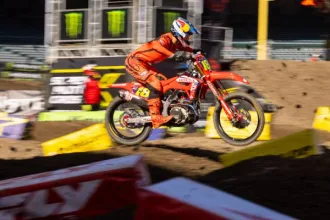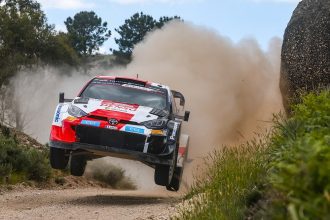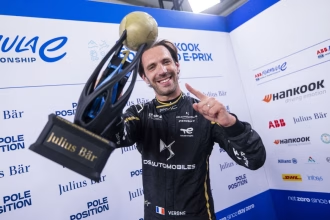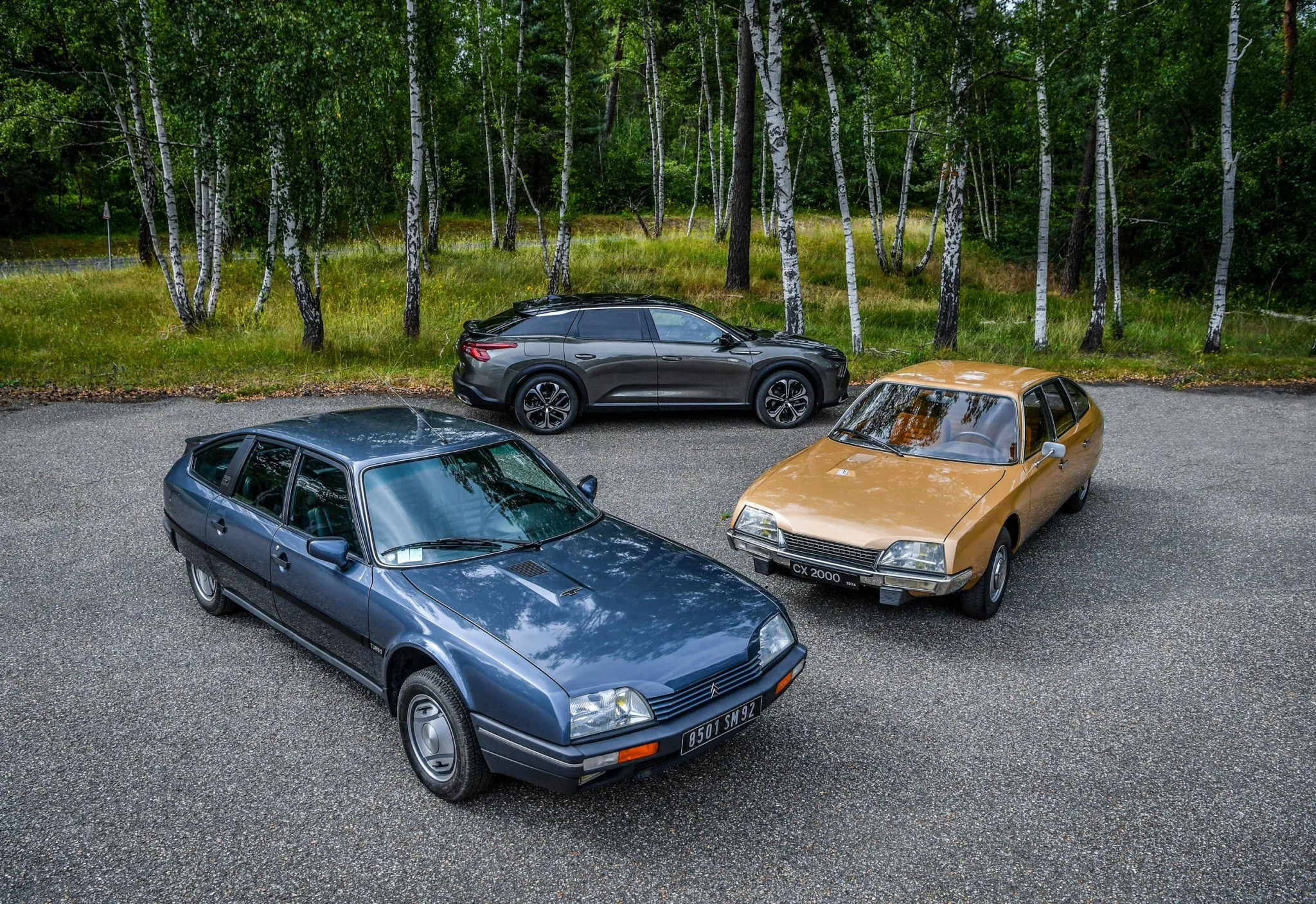- Synonymous with elegance and aerodynamics, the Citroën CX, launched at the end of August 1974, is celebrating its fiftieth anniversary.
- More than a million of these cars were produced over a 16-year period. Elected Car of the Year in 1975, it was also the car of choice for French presidents and rally drivers.
- Heir to the DS, its comfort and exemplary roadholding are now found in the Citroën C5 X.
Designed in 1974 to replace the DS, which itself succeeded the Traction, the CX is still remembered today as the great Citroën emblem of the Seventies and Eighties. Like its two prestigious predecessors, it benefits from numerous technical innovations which, throughout its seventeen-year career, have given it exceptional qualities and still set it apart in 2024. Its unique styling gives it an elegant, low-slung, aerodynamic identity that is instantly recognisable. The CX was replaced in the summer of 1989 by the XM, launched the previous May. However, its estate versions continued to be produced until the summer of 1991.
The CX, making the most of progress
The CX was officially launched on 26 August 1974, exactly two months after the announcement of the merger between Automobiles Citroën and Automobiles Peugeot. Presented to the press in Sweden the previous July, the twenty-two CX 2000s and CX 2200s used for testing made a remarkable return to Paris, to the Citroën shop on the Avenue des Champs-Elysées, as part of a 3,400-kilometre, six-day tour called the Raid Arctique 1974. At the wheel were twenty-two young people who had taken part in the Raid Afrique 1973 in a 2CV a year earlier.
Launched on 28 August 1974, the CX 2000 attracted a lot of attention at the Paris Motor Show the following October. The star of the Citroën stand, it was immediately recognised as an innovative car. From its predecessors, it took the front-wheel drive, hydropneumatic suspension and dual-circuit high-pressure power-assisted disc brakes now associated with Citroën’s image. But the newcomer also features a number of original innovations. The transverse four-cylinder engine is positioned in the front overhang and tilted forward to further optimise weight distribution and roadholding. For outstanding comfort, the monocoque body is connected to an axle frame by sixteen elastic links that filter out noise and vibration from the front and rear axles, as well as from the engine and gearbox.
Aesthetically, in addition to its particularly aerodynamic lines, as underlined by the name CX, the entire interior layout has been the subject of very detailed study. The most emblematic feature is undoubtedly the famous lunula-shaped instrument panel, which sits on the dashboard like a special vessel. Ergonomics and passive safety have not been forgotten.
First of all, all the usual controls that are essential for driving, such as the headlights, indicators, windscreen wiper and horn, are accessible at the tip of your fingers, without your hands ever leaving the steering wheel. All the trim and interior components have no aggressive protrusions, and their materials are designed to be as hard-wearing as the human body’s organs. Another innovation in 1974 was the retractable front seat belts.
Its many qualities obviously did not go unnoticed and, on 29 January 1975, it was awarded the 1975 Car of the Year Trophy by the European motoring press, well ahead of the Volkswagen Golf, Audi 50, Fiat 131 and Volvo 200. From July 1975, the CX also received the famous Diravi servo-assisted steering system from the SM. This new type of power steering, with its speed-dependent hardness, ensured exceptional steering in all conditions, whether dry, wet or snowy, and at all speeds. Initially available as an option, it will later be fitted as standard across the range.
Constant innovation
Over the years, the CX has also continued to evolve, receiving innovations and technical solutions that, for the most part, have become the norm half a century later. These include, for example:
- In 1975: air conditioning, electric windows on all four doors, two internally controlled exterior mirrors, rear fog lights;
- In 1976: a semi-automatic gearbox;
- In 1977: a petrol injection engine, five-speed gearbox, electric sunroof, foglights, transistorised electronic ignition and light alloy wheels;
- 1978: safety belts in the rear seats and automatic electro-magnetic door locks;
- In 1979: an electric oil dipstick on the dashboard;
- In 1980: a windscreen watering system integrated into the windscreen wiper, a fuel consumption economizer and an automatic gearbox;
- 1981: low-profile tyres and cruise control;
- In 1982: a central locking system with boot door and fuel filler flap;
- 1983: a turbocharged diesel engine and automatic cabin temperature control;
- 1984: a turbocharged petrol injection engine;
- In 1985: braking with anti-lock braking system (ABS), an ice detector, a faulty bulb indicator, a door-open signal, electrically-controlled heated door mirrors with tinted glass, an audible warning when the lights are on and central locking by infra-red remote control with synchronised activation of the interior ignition;
- In 1986: an automatic rear window defroster;
- In 1987: a turbocharged diesel engine with air-to-air heat exchanger, and a coded immobiliser;
Essential models
Throughout its career, the CX has been the subject of a particularly wide and rich range, with a wide range of engines. Some of these models have made a particularly strong impression, as much for their personality as for their exclusivity and excellence.
CX 2000
It was the first of all the CX models. It created quite a stir on the Citroën stand at the Paris Motor Show at the Porte de Versailles in October 1974. It was powered by a four-cylinder, 1,985 cm3, 11 bhp engine delivering 102 din hp. Backed up by the CX 2200 from January 1975 and the CX 2400 from July 1976, it disappeared in July 1979 with the launch of the CX Reflex and CX Athena equipped with a new 2-litre light alloy engine with overhead camshaft.
CX Prestige
Like the Traction and DS before it, the CX quickly established itself as the car for political figures. Mayors of major cities, prefects, senators, MPs, ministers and political figures all appreciated its elegance, comfort and safety. Of course, the Prime Minister and the President of the Republic were not to be outdone. Citroën soon decided to pay particular attention to this important clientele, and in February 1976 introduced the CX Prestige. In addition to a particularly elegant top-of-the-range finish with a vinyl roof and stainless steel trim, the CX Prestige also boasted increased rear-seat space, which was made possible by a body 25 cm longer on the wheelbase. In September 1978, its interior space was further enhanced by the adoption of a roof raised by four centimetres. Although it was fitted with the most powerful petrol engines, in November 1979 it gave birth to a diesel-engined version, the CX Limousine, with an improved CX Super finish.
CX Diesel and CX Turbo Diesel
In December 1975, Citroën confirmed its intention to develop a genuine range based on the CX and launched a diesel version of the CX 2200. From then on, the CX, in both saloon and estate versions, was the French car par excellence that would give the diesel engine its letters of nobility. Equipped with a turbocharger in April 1983, the apotheosis was reached in March 1987 with the CX 25 TRD Turbo 2, which received a new 2,500 cm3 engine with 120 bhp instead of 95, and a top speed of some 195 km/h!
CX Break, Family and Business
The flagship model of the CX range, the estate was launched in January 1976. With an interior volume of 2.03 m3 when the rear seats were folded down, it offered all the comfort, roadholding and braking qualities of the saloon. From October 1976, a family version with two rear seats was offered, providing no fewer than eight seats. Finally, the CX Enterprise appeared in spring 1984, the last and only commercial version of the CX Estate. Although it only had two front seats and its rear doors were closed, it offered a record length and usable volume of 2.03 m and 2,172 dm3 respectively. Available with petrol or diesel engines, the CX Estate very quickly became the benchmark, and ambulance drivers made no mistake, remaining loyal to it until the end of its career in the summer of 1991.
CX GTI, CX GTI Turbo and CX GTI Turbo 2
It was obvious that the CX would provide a worthy successor to the DS 23 IE and its electronic injection engine. This was achieved in May 1977 with the launch of the CX GTI equipped with a 2,347 cm3 L-Type Jetronic petrol injection engine. Developing 128 bhp and mated to a five-speed gearbox, it delivered a top speed of 189 km/h. On the outside, the CX GTI was distinguished not only by its special badging but also by matt black window frames, light alloy wheels (initially available as an option), two fog lamps and a front air deflector. In October 1984, a 2,500 cm3 turbocharged engine delivering 168 bhp was added to the range, transforming it into a CX GTI Turbo and enabling it to claim a top speed of 220 km/h! Finally, in July 1986, the car was renamed the CX GTI Turbo 2 with the addition of an air-air intake exchanger, which not only increased its top speed to 223 km/h, but also significantly reduced fuel consumption.
CX in competition, the queen of the slopes
The CX entered competition just 14 months after its presentation at the Paris Motor Show. On 26 December 1975, three CX 2200s set off on the famous Abidjan-Nice rally-raid, the same event that gave Thierry Sabine, then just a motorbike racer, the idea of organising a similar event between Paris and Dakar. After 9,246 km of tracks, mud, corrugated iron and stones, the three Citroëns overcame all the difficulties and reached the finish ranked 4e , 5e and 6e in the two-wheel drive category. From now on, Africa and long-distance events will be the new Citroën’s favourite terrain. Its robustness and hydropneumatic suspension enabled it to achieve a number of feats.
Rallye du Maroc, Rallye des Mille Pistes, London-Sydney, Rallye Acropole, Rallye 5 x 5 Transafrica and Rallye Paris-Dakar, the CX, whether standard or prepared, collects places of honour and category wins against much more powerful cars. And the longer, rougher and more difficult the events, the more its suspension and robustness work wonders! But it was in its new official tricolour livery, designed by Philippe Donati, a pupil at the famous Camondo school, that the CX scored a historic exploit at the 9e Tour Automobile du Sénégal. Thirty cars took part, including five CX 2400s. After four stages and 3,000 km in stifling heat, only seven cars crossed the finish line on 1er November 1977… The five factory-built CXs scored a legendary quintuple, beating out a Peugeot 504 TI and a Renault 16! The CXs also won the Tour Automobile du Sénégal in 1978 and 1979.
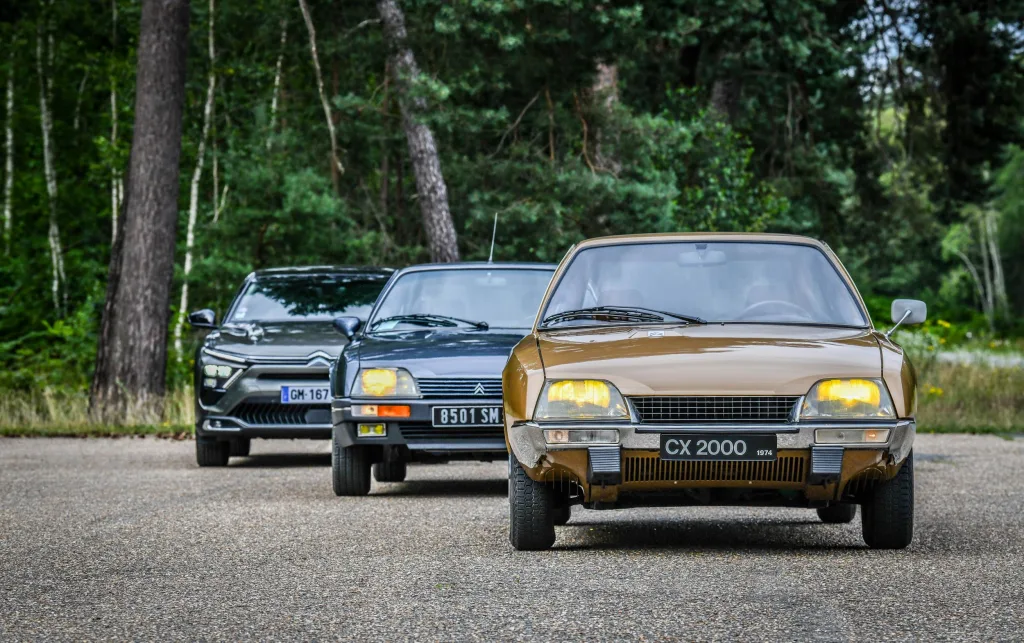
The Paris-Dakar Rally also enabled the CX to become a rally-raid legend. First of all, in autumn 1979, Citroën, which immediately understood the media potential of this extraordinary event, provided its organiser, Thierry Sabine, with four Méhari 4 x 4s and, above all, a CX 2400 GTI, which became a veritable standard-bearer. With this car, the reconnaissance for the second Paris-Dakar Rally was carried out with a bang. It was an opportunity for the big Citroën to impress Thierry Sabine with its qualities on all types of difficult terrain! The experience was repeated the following year.
But the best was yet to come. In 1981, a factory CX 2400 GTI finished the event in sixteenth place, ahead of many much more powerful 4x4s and, above all, first among the two-wheel-drive cars! However, another factory CX 2400 GTI, with more media coverage, made a strong impression on the event and on people’s minds. Entered by Citroën Belgium, it was driven for the first time by Jacky Ickx, then a four-time winner of the Le Mans 24 Hours, and actor Claude Brasseur. After putting on a great show at the front of the field, accumulating places of honour, winning one special stage after another and then a stage, it was one of the contenders for victory when it finished third overall in Gao. Despite two ten-hour penalties, she hung on and didn’t give up. Several rollovers on the penultimate stage finally forced her to retire…
Finally, still in 1981, on 4 December, as part of the Dubai Grand Prix organised in the United Arab Emirates by the Al Nasr Motor Sport Club, the astonishing Citroen CX Celebrity Race took place. For this extraordinary race, sixteen CX 2400 GTIs were entrusted to the elite of world motorsport, including Richard Attwood, Derek Bell, Jack Brabham, John Fitzpatrick, Dan Gurney, Phil Hill, Denny Hulme, Innes Ireland, Stirling Moss, Roy Salvadori, Carroll Shelby, Patrick Tambay and John Watson. The show was on. From the second lap onwards, the bodywork was rubbing up against each other and the chicanes and bends were largely cut through. The ten laps of the race literally turned into a stock-car event. The images of these sixteen furious CXs, bumper to bumper, went around the world! But with this ‘Race of Champions’ before its time, the CX ended its sporting career under the spotlights and the cameras. It now leaves its place in the competition department to the sparkling Visa and its budding trophy.
Aulnay, the birthplace of the CX
Commissioned in 1973, the Aulnay plant began assembling the CX in June 1974. At the time, it was the most modern car assembly plant in Europe. Bodywork, paintwork, upholstery and assembly were all carried out there. The use of computers and robots made it possible to automate the various stages of production to a very large extent, from the spot welding of bodywork components to the operation of the self-storage warehouse, from which the painted bodywork is transported to the assembly line according to its specific characteristics. This eliminates the need for tedious handling. The one millionth CX was produced on 23 October 1987. Having employed up to 8,000 people on a 180-hectare site covering 410,000 m2, production of the CX ceased in July 1989. Only estate car production continued at the Heuliez bodybuilder in Cerizay.
The CX advertising girl
Depending on the model presented, the CX is the subject of advertising that is sometimes sober and elegant in its image, sometimes dynamic and punchy, but always effective. They are signed by the famous RSCG advertising agency led by the emblematic Jacques Séguéla. For example, these advertisements appeared in the press at the beginning of the eighties, in which celebrities such as Françoise Hardy and Jacques Dutronc, or the actress Miou-Miou, spoke very highly of the CX in a particularly intimate black and white setting. But advertising for the CX also includes some particularly striking campaigns, with visuals signed by Jean-Paul Goude featuring the iconic model and actress Grace Jones.
For the launch of the CX GTI Turbo in October 1984, the photographer-videographer’s muse was at the centre of an aggressive and provocative campaign with the slogan “La CX GTI Turbo, c’est démon! Although this was banned under the pretext of road safety, she didn’t hesitate to highlight the top speed of 220 km/h of the new model with its turbocharged engine… The Minister of Transport at the time decreed that it should be banned, but in doing so gave this memorable campaign an audience that went into overdrive!
The CX in figures
Taking all models together, a total of 1,042,460 CXs were produced between 1974 and 1991. This figure breaks down into 913,375 saloons, including 29,380 long versions, from 1974 to 1989, and 129,085 estate cars, including 900 Enterprise, from 1976 to 1991.
The fiftieth anniversary of the CX
Two French CX collectors’ clubs, Agence CX and the CX Club de France, are joining forces to organise the CX Jubilee on Friday 13, Saturday 14 and Sunday 15 September at the Montigny-Le-Ganelon estate in Cloyes-Les-Trois-Rivières in the Eure-et-Loir region. Crews from all over France and Europe are expected to take part in what promises to be an unforgettable event. During these three days of passion, there will be a host of events on the programme, including an exclusive driving session on Friday on the circuit of the La Ferté-Vidame test centre. This is where the CX, like so many other Citroëns, first took to the road. Saturday will be open to the public.
C5 X a worthy heir
Although separated by several decades, the CX now finds a worthy heir in the C5 X, which shares the same bold styling and high ambitions in terms of comfort and technology. The CX was acclaimed in 1974 for its innovative aerodynamic design, marked by flowing lines and a low profile. The sleek C5 X combines the elegance of a saloon, the dynamism and practicality of an estate car with the protection and robustness of an SUV. Both models emphasise comfort, a central element of Citroën’s identity.
The CX was known for its hydropneumatic suspension, which provided a smooth, fluid ride, even on the roughest roads. The C5 X continues this tradition with a double-stop hydraulic suspension that reproduces the “magic carpet” effect so dear to Citroën. Complete with Citroën Advanced Comfort seats and optimum acoustic treatment, the C5 X is a veritable cocoon that invites you to travel in complete serenity. Finally, the CX introduced a number of innovations for its time, such as “Diravi” servo-controlled steering and a driver-focused instrument panel. The C5 X continues in this vein, offering modern technologies such as a head-up display, advanced driving aids and modern connectivity features to simplify everyday driving. These similarities show how Citroën has maintained continuity in its values and approach to the motoring experience.

